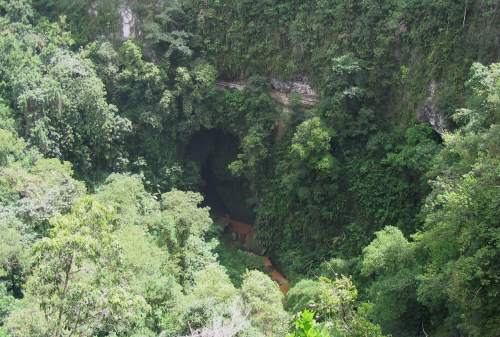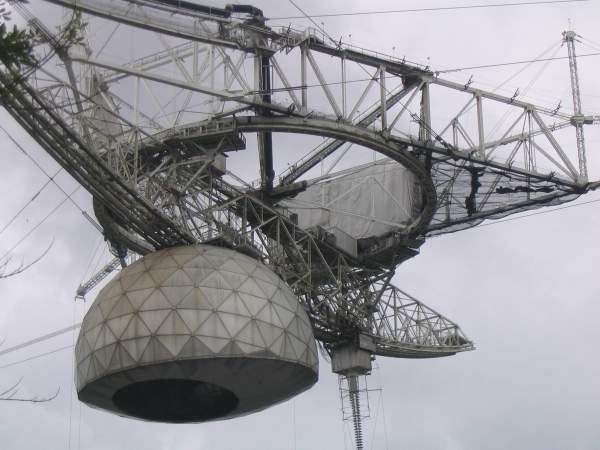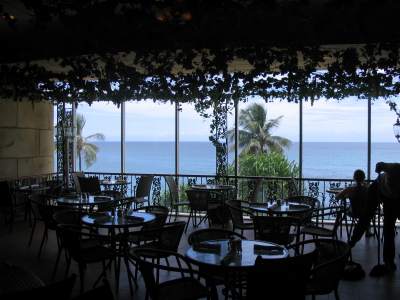

The exciting topic of Bioastronomy had taken me to Iceland in 2004. This year the next bioastronomy meeting took place in the Caribbean, in San Juan, the capital of Puerto Rico. (Bioastronomy 2007)
After exhausting 27 hours of travelling and 40 minutes at the lost luggage counter (my bag arrived on and a half days later), I was rewarded with a beautiful, spacious hotel room and a marvellous view to the sea.
|
|
|
Sunday evening the participants of the meeting were welcomed with drinks and good food. With a background of tropical temperatures and the light of Venus and Jupiter, the reception provided a good opportunity to get acquainted and to talk about this and that. (Lost luggage is a wonderful starter for a conversation!)
|
|
|
All through the week the temperature in San Juan was in the high 80ies and the humidity was something between 80% and 90%. Even during the nights it did not cool off. In the course of the week we experienced the full range of Caribbean weather: from bright sunshine to heavy clouds, torrential rain and a two-hour storm. Fortunately a hurricane was not part of the weather program! At the same time people at home in Vienna were melting away at temperatures in the 100s F! So actually, we had it nice and cool in Puerto Rico.
Mon, Tue, Thu and Fri were dedicated to the talks of the meeting. (See second report for details about the talks..) But there was also a social program with interesting highlights.
On Wednesday we were taken on a day trip to the Rio Camuy Caves and the Arecibo Observatory. I was assigned to coach no. 2. which featured a broken aircondition. At a temperature of something around 85 F at 7 a.m. and bright sunshine this was not very promising. But after somebody had the life-saving idea of opening the skylights in the roof of the coach, the trip was not too bad. Our very young driver assured us (in Spanish-English and with some good guessing on our side) that a new coach would be waiting for us when we had finished the tour through the cave.
|
|
|
The caves of Rio Camuy were washed out of the karst region by the river about a million years ago. Only 7 miles of the vast cave system has been explored so far. Visitors are guided through one of the large caves and two sinkholes. First a trolley took us down into the first sinkhole, where the entrance to the cave is located. The rainforest vegetation overgrows everything. While we were rattling down along the path we could admire the rich diversity of plants and for those who (other than me!!!!) are interested in spiders, there are plenty of specimen to study right next to the path. The cave is also home to the cave tarantula, which was, however, friendly enough not to show up.
|
|
|

One of numerous inhabitants of the forest.
The cave itself featues the typical stalactites, stalagmites and also drape-like formations made of the minerals washed out of the stone. Yet, the really unique sights here are the different vistas you get looking out of the cave onto the green and humid forest.
|
|
|

A walk through the world of a fantasy film!

Deep down you can see the Rio Camuy.
Back at the visitor center we hurried to the parking lot, awaiting an new, airconditioned coach. But - what else did you expect? - the substitute coach was not there yet and our old coach without aircondition had been grilled in the sun for hours and would only be used by sauna-fanatics. So we resorted to a cooler place under the trees, ate our lunch packets (which fortunately had been stored in the cool coach no.1) and waited. And waited a bit more. And watched the poor organizers trying to make a coach materialize out of their mobile phones.

Waiting for Godot, scientific stlye.
Finally, after about an hour, we were awarded with a wonderfully cooled coach, which took us to Arecibo Observatory at last.
The road lead us over and around uncounted littel hills, which are all very close together. The constant up and down and lots of curves make it a difficult trip for a big coach. Along the road I saw several huge bamboo plants, partly broken down or leaning dangerously towards the road. The vegetation overgrows everything in this hot climate, even the telephone or electric(?) cables and the poles that carry them.
From the parking lot at Arecibo a steep pathway leads uphill to the visitor center. It was extremely hot, extremely humid (there were even a few drops of rain). Puffing and panting we (at least I) made our way to the top only to find the comforting sign there: Do not run!!!! (Did ANYBODY think of running?)
|
|
|
I squeezed through the crowded visitor center and found the way to the visitor terrace. What a view!

Arecibo Observatory

Been there, done that!
The spherical 305m (1.000 feet) dish beneath us, the Gregorian enclosure high above us. That's the view we have been waiting for. The Gregorian enclosure harbors two reflectors, one 22m (72 feet) and the other 8m (26 feet), which bring the radio waves from the main dish to a focus. The whole sturcture is suspended between three high towers

The Gregorian enclosure
Arecibo Observatory is part of the National Astronomy and Ionosphere Center (NAIC) and is operated by Cornell University under cooperative agreement with the National Science Foundation. One of the original scientific aims was to study the Earth's ionosphere - a program that is still pursued. Besides that the observatory is used for various fields of research dealing with extraterrestrial objects. In the brochure about the observatory you can read, "Scientists can examine phenomena that occur as close as three kilometers (2 miles) above us in the Earth's atmosphere - or probe the hearts of quasars, objects 10 billion lightyears away, at the very edge of the discernible universe."
Arecibo is used for radio astronomy as well as for radar astronomy. The first of the two deals with the observation of radio waves emitted by objects in space. Radar astronomy measures radio signals, transmitted from the antenna, and reflected off an object in space. One major field of research in radar astronomy is the mapping of the surface of asteroids and planets like Venus or Mercury.
About three quarters of the observation time is dedicated to radio astronomy. Pulsars, stars, interstellar clouds, galaxies and quasars are among the obseved objects. Last but not least Arecibo has been used by the SETI institute to look for extraterrestrial intelligence.
Unfortunately we were not able to get to the Gregorian enclosure. (I would have loved to got there by cable car.) At the moment the observatory is shut down because of renovation work on the structure supporting the Gregorian. But we were taken in small groups (so that the regular tourists would not notice) down to the dish. "Down" meaning: first downhill then uphill and at last very steeply downhill again. Then we were underneath the rim of the dish, could even touch the aluminium panels it is made of. After all, this is one of the few astronomical "mirrors" that you can touch without being murdered for it!

Underneath the reflector dish.

The aluminium panels of the reflector.
The space underneath the reflector is overgrown with vegetation. In some spots the plants are already growing through the tiny holes in the panels. "Mowing the lawn" must certainly be a tough job in this tropical climate - and it must be done frequently!
|
|
|

A view from the control room.
In hot and muggy weather, with a rainstorm threatening to start any minute, we ended our tour with a short visit in the AIRCONDITIONED control room. Then we walked back to our buses (uphill, downhill), tired, hot, but full of great impressions.
On the next day I skipped the morning talks and took a taxi to Old San Juan. The most famous sights are the two fortresses, especially the older one, El Morro. Built in the 16th century this fort has never been conquered, not even by the famous English adventurer Sir Francis Drake.
|
|
|
|
|
|
In the 16th century the Spanish colonies in America were part of the Habsburg empire. Between 1519 and 1522 Puerto Rico and Austria were directly under the same ruler - Emperor Charles V (King Charles I of Spain), "in whose empire the sun never set". So it is not surprising to find an Austria Bastion in El Morro.
|
|
|
The closing event of the meeting was a public panel discussion and showing of the film Contact (after the novel by Carl Sagan), which had had its first night ten years ago. Seth Shostak and Jill Tarter of SETI Institute, who both had partly been "model" for the main characters in Sagan's novel, were among the panelists. Before the start of the film I had to say good bye and leave. My flight was leaving early the next morning and I still had to pack. An unforgettable week at an exotic location came to an end.

A last glimps at the palm trees and the sea from one of the hotel's restaurants.

Then I had to say good bye to Puerto Rico.
Text und photos: Anneliese Haika